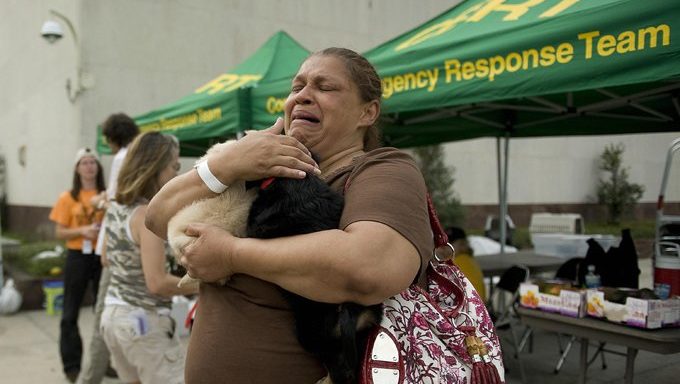Wildfires, hurricanes, earthquakes, and other natural disasters can occur without warning, forcing thousands to flee their homes. Evacuation procedures have improved in recent years, and more plans are including pets.
Keeping pets safe in a natural disaster can be difficult, especially because many relief shelters cannot accept animals due to health and safety concerns for the public. However, some do accept pets, which is why you should check in advance and have a disaster plan.
In southern California every year, wildfires force evacuations; floods, hurricanes, and tornadoes affect other parts of the country, and the world. Evacuees are often left with little time to gather their loved ones and belongings and get out.
Many credit the lessons learned from Hurricane Katrina for helping states and communities come up with plans for pets in the event of a mass evacuation. Since then, the Humane Society has helped spearhead a national movement to make sure animals are included in any broad emergency relief effort.
As a concerned pet parent, you should have a disaster plan that includes all of your family members, including the non-human ones. Here are a few tips.
Protect Your Pets In A Natural Disaster

The best approach to dealing with any disaster is to be prepared.
Here are the steps the Humane Society suggests you take now in the event of a natural disaster that forces you to leave your home with your pets:
- Ready your pet’s crate, or carrier. And if you don’t have one, get one. Be sure it’s large enough for your cat or dog to comfortably stand up and turn around in. Introduce your pet to their crate by occasionally putting treats or toys in it. Your pet’s positive association will make a speedy exit easier.
- Set aside supplies. You should have enough pet food and water for at least three days. Also, have a leash or and harness on hand. Keep your pet’s vet records handy. Having them on a USB drive will save you space and time.
- Know your options. Find out which disaster relief locations in your area accept pets in the event of an emergency or evacuation (many do not), and identify which hotels or motels in the area allow pets, or make exceptions in emergencies.
- Arrange backup. Make plans with trustworthy neighbors or friends to get your pets in case you can’t get back home quickly when disaster strikes.
- Microchip. Your dog may get loose from their collar, but their chip will remain with them their entire life. If you’ve got a cat, microchip them, as well.
- Keep a recent photo of your pet on hand. In the event you become separated from your pet, you’ll want to be able to provide a picture, as well as prove the animal is yours once you’re reunited.
- Leave early. If there’s even a small chance you’ll need to evacuate, just go, and take your pets with you.
For more information on how to take care of pets in an emergency, contact the Humane Society or the ASPCA.
Do you have a disaster plan for your pets? What do you keep in your emergency to-go bag? Let us know in the comments below!









